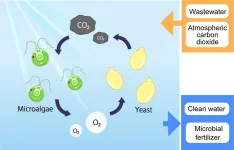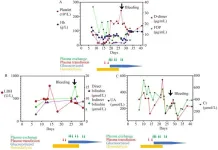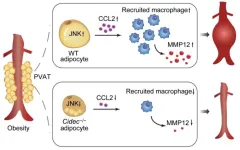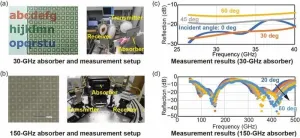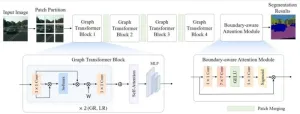(Press-News.org) As cancer cells grow, they pump out metabolic byproducts such as lactic acid into the tumor microenvironment. Exhausted T cells — which have lost their cancer-fighting oomph — consume this lactic acid, which further saps their energy, according to new research from the University of Pittsburgh and UPMC Hillman Cancer Center.
When the researchers blocked the protein that imports lactic acid into cells, exhausted T cells gained a new lease on life, which led to improved tumor control in mouse models of cancer. The findings are published today in Nature Immunology.
“Blocking access to inhibitory metabolites is a completely new take on how we can reinvigorate the immune system,” said senior author Greg Delgoffe, Ph.D. professor of immunology at Pitt and director of the Tumor Microenvironment Center at UPMC Hillman. “We often think of exhausted T cells being useless, but this study shows that we can actually get juice out of these cells by blocking negative effects of the tumor microenvironment.”
When continually exposed to tumors, T cells progressively become less effective due to expression of coinhibitory receptors that act like brakes. Progenitor exhausted T cells, which still retain some cancer-killing function, can deteriorate further to a terminally exhausted state. Most immunotherapies, including the checkpoint inhibitor drugs anti-PD1 and anti-CTLA4, attempt to release these brakes by blocking coinhibitory receptors.
“Checkpoint inhibitors, which are the main weapons in our immunotherapy arsenal, have been incredibly successful for some patients with certain cancers, but there have also been a lot of failures, and they haven’t been the gamechangers we expected in many cancers,” said Delgoffe. “There’s only so much you can do by taking your foot off the brake.”
On the hunt for new ways to jumpstart tired T cells, Delgoffe and first author Ronal Peralta, Ph.D., postdoctoral fellow in Delgoffe’s lab, started by looking at a family of proteins called solute carriers, which transport nutrients into cells.
“Exhausted T cells have been studied extensively in terms of what they can no longer do,” said Peralta. “But what do exhausted T cells do? What do they eat? What nutrients do they have access to? These questions were the starting point of our study.”
Peralta found that a solute carrier called MCT11, which imports lactic acid, was dramatically increased in terminally exhausted T cells compared to their progenitor versions, suggesting that lactic acid contributes to loss of function.
When he deleted the gene encoding MCT11 in mice or blocked the protein with a monoclonal antibody, T cells ingested less lactic acid and showed improved functionality and tumor control in mouse models of melanoma, colorectal carcinoma and head and neck cancer.
If coinhibitory receptors that lead to T cell exhaustion are the brakes on a car, lactic acid is like poor quality gas contaminated with dirt and particulates that hinders the vehicle’s performance. By blocking access to the gas station that sells this subpar fuel, the car accesses better gas that improves its performance — just like blocking MCT11 stops T cells from accessing lactic acid that impedes their function.
“When we get rid of MCT11, there’s no difference in the expression of coinhibitory receptors on T cells,” explained Delgoffe. “They’re still technically exhausted, but they behave as functional T cells because we cut off the tap of this bad metabolite, lactic acid.”
The researchers found that the MCT11 antibody promoted clearance of tumors in mice when given alone, but it was even more effective when combined with anti-PD1.
Through their new spinout company, Delgoffe and Peralta are now working to optimize the MCT antibody for effectiveness in human T cells, with the goal of testing it in future clinical trials.
According to Peralta, MCT11 is an attractive therapeutic target because it is almost exclusively expressed in exhausted T cells, which are concentrated in tumors. This means that drugs targeting MCT11 could have fewer side effects than traditional immunotherapies such as anti-PD-1, which act on T cells throughout the body.
“This research is really exciting because it’s proof-of-concept that targeting how T cells interact with metabolites in their environment can promote better outcomes in cancer,” said Peralta. “It opens the door for exploring how we can go after other targets in immune cells for treating cancer and many other diseases.”
Other authors on the study were Bingxian Xie, Ph.D., Konstantinos Lontos, M.D., Ph.D., Hector Nieves-Rosado, Ph.D., Kellie Spahr, Supriya Joshi, Ph.D., Rhodes B. Ford, Kevin Quann, M.D., Ph.D., Andrew Frisch, Victoria Dean, Mary Philbin, Anthony R. Cillo, Ph.D., Sebastian Gingras, Ph.D., Amanda C. Poholek, Ph.D., Lawrence P. Kane, Ph.D., and Dayana B. Rivadeneira, Ph.D., all of Pitt and UPMC.
This research was supported by the National Institutes of Health (DP2AI136598, P50CA121973 and P50CA097190), the National Institute of Allergy and Infectious Disease (R01AI171483, R01AI166598), the Hillman Fellows for Innovative Cancer Research Program, Stand Up to Cancer (SU2C-AACR-IRG-04-16), the Alliance for Cancer Gene Therapy, the Mark Foundation for Cancer Research’s Emerging Leader Award, a Cancer Research Institute Lloyd J. Old STAR Award and the Sy Holzer Endowed Immunotherapy Fund.
END
New take on immunotherapy reinvigorates T cells by blocking uptake of energy-sapping cancer byproducts
2024-11-08
ELSE PRESS RELEASES FROM THIS DATE:
How much climate change is in the weather?
2024-11-08
Only a few weeks ago, massive precipitation produced by the storm “Boris” led to chaos and flooding in Central and Eastern Europe. An analysis conducted by the Alfred Wegener Institute shows that in a world without the current level of global warming Boris would have deposited roughly nine percent less rain. Such conclusions can be drawn thanks to a new modelling approach called ‘storylines’. How it can be used in near-real-time was just presented in the Nature journal Communications Earth & Environment. At the same time, the AWI team released a freely available online tool that ...
Flagship AI-ready dataset released in type 2 diabetes study
2024-11-08
Researchers today (Nov. 8, 2024) are releasing the flagship dataset from an ambitious study of biomarkers and environmental factors that might influence the development of type 2 diabetes. Because the study participants include people with no diabetes and others with various stages of the condition, the early findings hint at a tapestry of information distinct from previous research.
For instance, data from a customized environmental sensor in participants’ homes show a clear association between disease state and exposure to tiny particulates of pollution. ...
Shaking it up: An innovative method for culturing microbes in static liquid medium
2024-11-08
Culturing, a term for growing microorganisms in the laboratory, is a basic yet indispensable method in microbiology research. Microorganisms are often cultured in a liquid medium that provides essential nutrients, and this process is both simple and highly effective. In addition to nutrients, oxygen availability is also critical for the growth of aerobic microorganisms. However, oxygen does not dissolve easily in the liquid medium. As a result, the medium needs to be forcibly aerated, usually by shaking.
Several techniques have been developed for better aeration of “shake” cultures, including “baffled” shake flasks, which have indentations designed to improve oxygen ...
Greener and cleaner: Yeast-green algae mix improves water treatment
2024-11-08
Bakeries and wineries can’t do without yeast, but they have no need for green algae. Wastewater treatment facilities, however, might just want to have these microorganisms team up. Osaka Metropolitan University researchers have discovered that these simple organisms form the best combination in terms of boosting wastewater treatment efficiency.
The active sludge method of wastewater treatment requires electricity to ensure the flow of oxygen that feeds bacteria and other organisms that process the water. Adding microalgae ...
Acquired immune thrombotic thrombocytopenic purpura (TTP) associated with inactivated COVID-19 vaccine CoronaVac
2024-11-08
The COVID-19 pandemic has prompted the rapid development and administration of various vaccines worldwide, with some reports linking these vaccines to immune thrombotic thrombocytopenic purpura (TTP). This report presents two cases of TTP occurring after the administration of the inactivated vaccine CoronaVac from Sinovac Biotech, highlighting the potential association between this type of vaccine and TTP. The article also provides an analysis of TTP incidence in the Nanjing area of China, suggesting a possible correlation between COVID-19 vaccination and the occurrence of TTP.
The first case details a 23-year-old female who developed symptoms of TTP three days ...
CIDEC as a novel player in abdominal aortic aneurysm formation
2024-11-08
Abdominal aortic aneurysm (AAA) is a degenerative lesion characterized by structural disruption of the abdominal aortic wall and progressive dilatation into a pulsatile mass. AAA is strongly associated with obesity, partly due to abnormal dilatation of perivascular adipose tissue (PVAT) in the abdomen, however, direct evidence is still lacking.
Cell death-inducing DNA fragmentation factor-like effector C (CIDEC), also known as fat-specific protein 27 (FSP27) in rodents, is a lipid droplet (LD)-associated protein that plays an important role in lipid storage. It has been reported that CIDEC/FSP27 promotes the growth of LDs by mediating the exchange and transfer of lipids ...
Artificial intelligence: a double-edged sword for the environment?
2024-11-08
As artificial intelligence (AI) technology progresses, the energy demands of training complex models have surged, raising widespread concerns about associated carbon emissions. This rapid growth is fueled by global demand across industries and academia, leading to exponential increases in computing power that carry significant environmental consequences. Given these challenges, in-depth research is essential to fully understand AI's carbon footprint and develop strategies for mitigating its environmental impact.
In a view (DOI: 10.1007/s11783-024-1918-y) by ...
Current test accommodations for students with blindness do not fully address their needs
2024-11-08
Tsukuba, Japan—Students often appear for high-stakes tests that hold significant weight in determining their futures. One such examination, the Common Test for University Admissions, currently allows examinees using braille an extended examination time of 1.5 times the standard duration. However, with the recent increase in complex questions and questions involving charts and diagrams in such tests, it is necessary to review whether the current accommodations remain adequate.
The researchers assessed the validity of the current time extension for examination questions containing complex tables by measuring the time required to read the text and complex tables. The results showed that ...
Wide-incident-angle wideband radio-wave absorbers boost 5G and beyond 5G applications
2024-11-08
5G wireless communication services have rapidly expanded worldwide, leveraging millimeter-wave (mmW) frequencies in the 24 GHz to 71 GHz range (referred to as frequency range 2, or FR2). Looking ahead, Beyond 5G and 6G services, projected to offer ultra-fast connectivity exceeding 100 Gbit/s, are expected to be introduced in the 2030s. Frequencies in the 150-GHz to 300-GHz range are being considered as potential candidates for these future networks. However, critical components such as radio-wave absorbers, essential for packaging and modularization, still need to be developed. These absorbers play a key role in reducing ...
A graph transformer with boundary-aware attention for semantic segmentation
2024-11-08
The transformer-based semantic segmentation approaches, which divide the image into different regions by sliding windows and model the relation inside each window, have achieved outstanding success. However, since the relation modeling between windows was not the primary emphasis of previous work, it was not fully utilized.
To solve the problems, a research team led by Zizhang Wu published their new research on 15 October 2024 in Frontiers of Computer Science co-published by Higher Education Press and Springer ...




